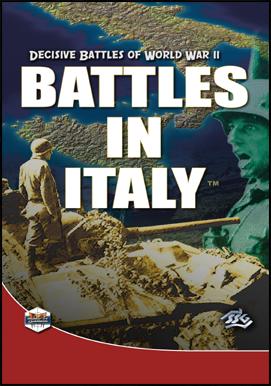INTRODUCTION
Battles in Italy covers three
pivotal battles from the Italian Campaign. The invasion of Sicily, codenamed
Operation Husky, the landings at Salerno, codenamed Operation Avalanche and
the landings at Anzio, codenamed Operation Shingle. While the invasion of
Sicily went more or less to plan, the result in the two subsequent
amphibious operations was less certain, with the safety of the beachheads at
both Salerno and Anzio in considerable doubt for some time. Neither side has
sufficient resources to do the job properly, and improvisation and
desperation are the order of the day, and as a result all three battles are
tense and exciting affairs.
In Operation Husky, the invasion of Sicily, the
Axis player must plan carefully in order to extract the best possible
performance from some less than committed Italian troops, while the Allied
player must somehow find a way around or through the many natural defensive
obstacles in their way.
In Operation Avalanche, the invasion of the Italian
mainland, the Germans can exert severe pressure on the Salerno beachhead,
but must defend against Allied forces coming to the relief of the amphibious
forces. The Allies must hold fast to their bridgeheads and their vulnerable
supply sources, while speeding other formations to the rescue.
Operation Shingle, the Anzio landing, was a bold
Allied move to break the stalemate caused by the strength of German
defensive lines. The Germans have a real chance to crush the Anzio
bridgehead, especially if they transfer troops from their main defensive
line. However, if the Allies can break through the weakened lines while
avoiding disaster at Anzio then a truly decisive victory is possible.
GAME FEATURES
Three complete battles, Sicily, Salerno and Anzio
New rules for Surrender and Political Units
New rules for co-operation between countries
Improved User Interface
Maximum map size increased by 12 times
New Defensive AI routines
Increased variability for country based variables
New capacity for Naval Transport
New features for Merging Units
|
|
BACKGROUND
Did the Italian campaign ultimately constitute a
Churchillian thrust into the ‘soft underbelly of Europe’ or was it the strategic
sideshow predicted by many, including most of the American high command? The
answer, as so often with the big questions in history, depends on the criteria
used to measure success. Viewed purely as a military exercise in gaining ground,
the campaign was an Allied failure. The secondary nature of the theatre, the
weather and terrain, German tactical excellence and high level command failures
on the Allied side all conspired to prevent the dramatic military breakthrough
that might have caused history to re-evaluate the campaign. It also has to be
said that it is doubtful that any success, no matter how staggering, could have
decisively affected the outcome of the war, which was being settled on the
Russian front.
However, war has always been about more than just
lines on a map. The Italian campaign was the almost inevitable outcome of
Churchill’s successful politicking, which had convinced Roosevelt to support
Operation Torch, the invasion of North Africa. Once the Allied war machine had
been cranked up and aimed at the Mediterranean, it was easy to find any number
of plausible reasons why further operations in the theatre were necessary. This
situation perfectly suited Churchill and the British command, who wished to
avoid what they saw as a premature confrontation with the German army in the
European theatre in 1943. They were successful in this, and as the Allies
initial lack of progress in Normandy in 1944 showed, their caution may well have
been justified, as the German defenders of Europe in 1943 would have been a much
tougher proposition.
As
well as avoiding a high risk invasion, the Italian campaign provided other
benefits. The Allied war machine, at all levels, still had a lot to learn about
warfare, as embarrassing reverses in North Africa at Kasserine and
elsewhere had already shown. The technical mastery of amphibious warfare shown
at Normandy would surely not have been possible without the experience gained in
battle in the various Mediterranean operations. It was also useful and necessary
to show both the Russians and the home front that the Germans were being
confronted. In some ways, Allied soldiers in the Italian campaign were like the
airmen of Bomber Command. They were thrown against the enemy as a necessity of
war, and the fact that these battles were not on the direct path to victory does
not in the slightest diminish their dedication or sacrifice. Their German
opponents showed similar dedication, and could at least console themselves with
the thought that they were not serving on the Russian front.
Far removed from lofty strategic considerations, the fighting in the Italian
Campaign was some of the hardest of the war. Conditions in Sicily were
relatively benign, and the Germans were content to fight a delaying campaign,
withdrawing more or less at their convenience. However, terrain and weather on
almost all of the Italian mainland were perversely unsuited to offensive
operations by a modern mechanised army and these factors, together with the
fighting abilities of the German army meant that Allied attacks were usually
made at great cost for little gain
REQUIREMENTS
Windows 98 / Me / 2000 / XP
Pentium II 600 MHz CPU
256 MB RAM
DirectX 8.1
8 MB Video Card 16bit color
Sound Card (DirectX 8 comp.)
8x CD-ROM
600 MB free Hard Disk space
AVAILABILITY
As of 5th May 2005 - Very Soon
SCREEN SHOTS
1st Airborne to the rescue
Allied forces struggle to expand the Salerno bridgehead
British forces start the long trek north to Naples
British landings on Sicily
British open the way to Catania
Defensive line forms in front of the British
Last line of defence at Anzio
No easy way through the Gustav line
Operation Avalanche
Operation Husky
Operation Shingle
The Anzio bridgehead is contained
US paras take casualties
MUSIC
Battles In Italy samples original music of the third reich produced by Tomahawk Films.


